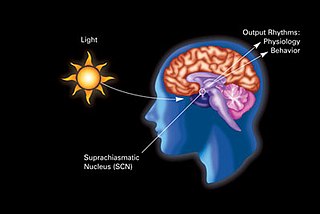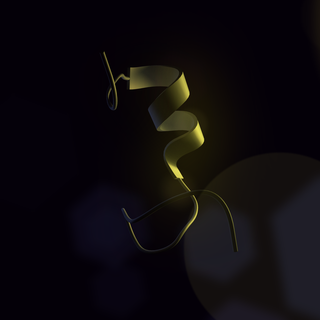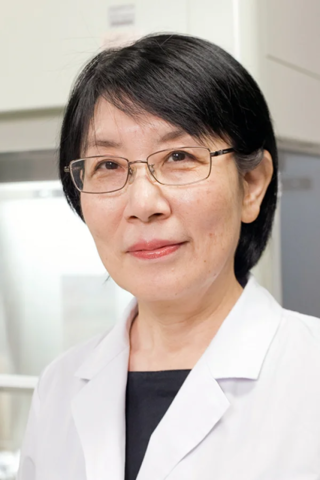
A circadian rhythm, or circadian cycle, is a natural oscillation that repeats roughly every 24 hours. Circadian rhythms can refer to any process that originates within an organism and responds to the environment. Circadian rhythms are regulated by a circadian clock whose primary function is to rhythmically co-ordinate biological processes so they occur at the correct time to maximise the fitness of an individual. Circadian rhythms have been widely observed in animals, plants, fungi and cyanobacteria and there is evidence that they evolved independently in each of these kingdoms of life.

Chronobiology is a field of biology that examines timing processes, including periodic (cyclic) phenomena in living organisms, such as their adaptation to solar- and lunar-related rhythms. These cycles are known as biological rhythms. Chronobiology comes from the ancient Greek χρόνος, and biology, which pertains to the study, or science, of life. The related terms chronomics and chronome have been used in some cases to describe either the molecular mechanisms involved in chronobiological phenomena or the more quantitative aspects of chronobiology, particularly where comparison of cycles between organisms is required.

The suprachiasmatic nucleus or nuclei (SCN) is a small region of the brain in the hypothalamus, situated directly above the optic chiasm. The SCN is the principal circadian pacemaker in mammals, responsible for generating circadian rhythms. Reception of light inputs from photosensitive retinal ganglion cells allow the SCN to coordinate the subordinate cellular clocks of the body and entrain to the environment. The neuronal and hormonal activities it generates regulate many different body functions in an approximately 24-hour cycle.
Gene David Block is an American biologist who has served as the current and 6th chancellor of the University of California, Los Angeles since August 2007.

In neuroanatomy, the retinohypothalamic tract (RHT) is a photic neural input pathway involved in the circadian rhythms of mammals. The origin of the retinohypothalamic tract is the intrinsically photosensitive retinal ganglion cells (ipRGC), which contain the photopigment melanopsin. The axons of the ipRGCs belonging to the retinohypothalamic tract project directly, monosynaptically, to the suprachiasmatic nuclei (SCN) via the optic nerve and the optic chiasm. The suprachiasmatic nuclei receive and interpret information on environmental light, dark and day length, important in the entrainment of the "body clock". They can coordinate peripheral "clocks" and direct the pineal gland to secrete the hormone melatonin.

Period circadian protein homolog 1 is a protein in humans that is encoded by the PER1 gene.

Jürgen Walther Ludwig Aschoff was a German physician, biologist and behavioral physiologist. Together with Erwin Bünning and Colin Pittendrigh, he is considered to be a co-founder of the field of chronobiology.
Joseph S. Takahashi is a Japanese American neurobiologist and geneticist. Takahashi is a professor at University of Texas Southwestern Medical Center as well as an investigator at the Howard Hughes Medical Institute. Takahashi's research group discovered the genetic basis for the mammalian circadian clock in 1994 and identified the Clock gene in 1997. Takahashi was elected to the National Academy of Sciences in 2003.
Colin Stephenson Pittendrigh was a British-born biologist who spent most of his adult life in the United States. Pittendrigh is regarded as the "father of the biological clock," and founded the modern field of chronobiology alongside Jürgen Aschoff and Erwin Bünning. He is known for his careful descriptions of the properties of the circadian clock in Drosophila and other species, and providing the first formal models of how circadian rhythms entrain (synchronize) to local light-dark cycles.
Michael Menaker, was an American chronobiology researcher, and was Commonwealth Professor of Biology at University of Virginia. His research focused on circadian rhythmicity of vertebrates, including contributing to an understanding of light input pathways on extra-retinal photoreceptors of non-mammalian vertebrates, discovering a mammalian mutation for circadian rhythmicity, and locating a circadian oscillator in the pineal gland of bird. He wrote almost 200 scientific publications.
Ueli Schibler is a Swiss biologist, chronobiologist and a professor at the University of Geneva. His research has contributed significantly to the field of chronobiology and the understanding of circadian clocks in the body. Several of his studies have demonstrated strong evidence for the existence of robust, self-sustaining circadian clocks in the peripheral tissues.

Douglas G. McMahon is a professor of Biological Sciences and Pharmacology at Vanderbilt University. McMahon has contributed several important discoveries to the field of chronobiology and vision. His research focuses on connecting the anatomical location in the brain to specific behaviors. As a graduate student under Gene Block, McMahon identified that the basal retinal neurons (BRNs) of the molluscan eye exhibited circadian rhythms in spike frequency and membrane potential, indicating they are the clock neurons. He became the 1986 winner of the Society for Neuroscience's Donald B. Lindsley Prize in Behavioral Neuroscience for his work. Later, he moved on to investigate visual, circadian, and serotonergic mechanisms of neuroplasticity. In addition, he helped find that constant light can desynchronize the circadian cells in the suprachiasmatic nucleus (SCN). He has always been interested in the underlying causes of behavior and examining the long term changes in behavior and physiology in the neurological modular system. McMahon helped identifying a retrograde neurotransmission system in the retina involving the melanopsin containing ganglion cells and the retinal dopaminergic amacrine neurons.

Carl Hirschie Johnson is an American-born biologist who researches the chronobiology of different organisms, most notably the bacterial circadian rhythms of cyanobacteria. Johnson completed his undergraduate degree in Honors Liberal Arts at the University of Texas at Austin, and later earned his PhD in biology from Stanford University, where he began his research under the mentorship of Dr. Colin Pittendrigh. Currently, Johnson is the Stevenson Professor of Biological Sciences at Vanderbilt University.
In the field of chronobiology, the dual circadian oscillator model refers to a model of entrainment initially proposed by Colin Pittendrigh and Serge Daan. The dual oscillator model suggests the presence of two coupled circadian oscillators: E (evening) and M (morning). The E oscillator is responsible for entraining the organism’s evening activity to dusk cues when the daylight fades, while the M oscillator is responsible for entraining the organism’s morning activity to dawn cues, when daylight increases. The E and M oscillators operate in an antiphase relationship. As the timing of the sun's position fluctuates over the course of the year, the oscillators' periods adjust accordingly. Other oscillators, including seasonal oscillators, have been found to work in conjunction with circadian oscillators in order to time different behaviors in organisms such as fruit flies.

Sato Honma is a Japanese chronobiologist who researches the biological mechanisms of circadian rhythms. She mainly collaborates with Ken-Ichi Honma on publications, and both of their primary research focuses are the human circadian clock under temporal isolation and the mammalian suprachiasmatic nucleus (SCN), its components, and associates. Honma is a retired professor at the Hokkaido University School of Medicine in Sapporo, Japan. She received her Ph.D. in physiology from Hokkaido University. She taught physiology at the School of Medicine and then at the Research and Education Center for Brain Science at Hokkaido University. She is currently the director at the Center for Sleep and Circadian Rhythm Disorders at Sapporo Hanazono Hospital and works as a somnologist.
Johanna H. Meijer is a Dutch scientist who has contributed significantly to the field of chronobiology. Meijer has made notable contributions to the understanding of the neural and molecular mechanisms of circadian pacemakers. She is known for her extensive studies of photic and non-photic effects on the mammalian circadian clocks. Notably, Meijer is the 2016 recipient of the Aschoff and Honma Prize, one of the most prestigious international prizes in the circadian research field. In addition to still unraveling neuronal mechanisms of circadian clocks and their applications to health, Meijer's lab now studies the effects of modern lifestyles on our circadian rhythm and bodily functions.
The food-entrainable oscillator (FEO) is a circadian clock that can be entrained by varying the time of food presentation. It was discovered when a rhythm was found in rat activity. This was called food anticipatory activity (FAA), and this is when the wheel-running activity of mice decreases after feeding, and then rapidly increases in the hours leading up to feeding. FAA appears to be present in non-mammals (pigeons/fish), but research heavily focuses on its presence in mammals. This rhythmic activity does not require the suprachiasmatic nucleus (SCN), the central circadian oscillator in mammals, implying the existence of an oscillator, the FEO, outside of the SCN, but the mechanism and location of the FEO is not yet known. There is ongoing research to investigate if the FEO is the only non-light entrainable oscillator in the body.
Ken-Ichi Honma is a Japanese chronobiologist who researches the biological mechanisms underlying circadian rhythms. After graduating from Hokkaido University School of Medicine, he practiced clinical psychiatry before beginning his research. His recent research efforts are centered around photic and non-photic entrainment, the structure of circadian clocks, and the ontogeny of circadian clocks. He often collaborates with his wife, Sato Honma, in work involving the mammalian suprachiasmatic nucleus (SCN), its components, and associated topics.
Professor Alex A.R. Webb is a plant biologist whose computational, genetic, and physiological studies center around plant chronobiology. He currently serves as the head of the Circadian Signal Transduction Group in the University of Cambridge's Department of Plant Sciences researching circadian pathways and what regulates them.
Martin R. Ralph is a circadian biologist who serves as a professor in the Psychology Department at the University of Toronto. His research primarily focuses on circadian rhythmicity in the fields of neuroscience, psychology, and endocrinology. His most notable work was has been on the suprachiasmatic nucleus, now recognized as the central circadian pacemaker in mammals, but has also investigated circadian rhythms in the context of time, memory, and light.










